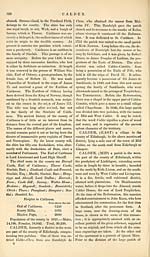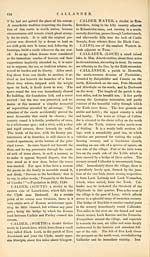Gazetteer of Scotland > Volume 1
(151) Page 123
Download files
Complete book:
Individual page:
Thumbnail gallery: Grid view | List view

C A L D E R.
123
Calder- Comitis, it was distinguished as the
ministerial charge of John Spottiswood, Super-
intendent of Lothian, a son of Spottiswood of
Spottiswood in Lauderdale, and the father of
the historian Archbishop Spottiswood, who
was born here in 1565. — (See St. Andrews.)
The town of Mid Calder is situated on the
south road from Edinburgh to Glasgow, about
twelve miles from the former city, in a south-
westerly direction. It is pleasantly situated
on a peninsular eminence between the small
water of Linnhouse and the Almond. It pos-
sesses an old Gothic church of elegant archi-
tecture, which appears to have been left in an
unfinished condition. There is also a dissent-
ing meeting-house in the town. Calder wood
overhangs it on one side. Tbere are two
paper mills in the neighbourhood, and lime-
stone is abundant. Two annual fairs are held
here.— Population in 1821, 1410.
CALDER, (WE ST) a parish in the south-
western extremity of the county of Edinburgh,
of a triangular shape, and often miles in length ;
bounded on the south and west by Carnwath,
on the east by Mid Calder, and on the north
by Livingstone and Whitburn, from which it
is divided by the Breich water, a tributary of
the Almond. The original character of this
high-lying district was bleak and unpromising,
but much has been done to improve the soil
and climate, and a great deal of wood has been
planted by Mr. Young of Harbuni, the late
Lord Hermand, Mr. Moubray of Hartwood,
and others. The parish abounds in coal and
ironstone, and has some quarries of fimestone.
The parish town is a small village on the road
from Edinburgh to Lanark, lying seventeen
miles from the former. Besides the parish
church, it has a dissenting meeting-house. —
Population in 1821, 1458.
CALDER, a parish in the counties of
Nairn and Inverness, four miles in length, with
a general breadth of two miles, except at one
place where it is seven or eight miles. It lies
at the distance of five or six miles from the
sea, bounded by Nairn on the north. The
greater proportion of it is moorish, and the
low grounds are very liable to be overflowed
by the river Nairn and the Calder water. The
river Findhorn passes the parish on its south-
eastern extremity, and the hilly country is
partly covered with natural woods. Calder
or Cawdor castle, still in considerable preser-
vation, stands in this parish near a small lake.
It furnished the second title to Macbeth, and
was, at one time, when defended with a draw-
bridge and moat, a place of great strength,
The romantic grounds around it are now beau-
tifully planted with shrubbery. The estate of
Calder has long been in the possession of a
branch of the family of Argyle, which has
latterly been ennobled, under the title of Lord
Cawdor, which was changed into an earl-
dom in the year 1827. An accurate and
minute description of Cawdor castle has been
given by Mr. Fraser Tytler, in the second vo-
lume of the Edinburgh Philosophical Trans-
actions. " The whole of Cawdor castle is
peculiarly calculated to impress the mind with
a retrospect of past ages, feudal customs, and
deeds of darkness. Its iron-grated doors, its
ancient tapestry, hanging loosely over secret
doors and hidden passages, its winding stair-
cases, its rattling draw-bridge, all conspire to
excite the most gloomy imagery in the mind.
It was indeed a fertile spot for the writers of
our modern romances. The mysteries of
Udolpho would vanish in contemplation of the
less perspicuous intricacies in the castle of
Cawdor. Among these must be mentioned,
the secret apartment which so effectually con-
cealed Lord Lovat from the sight of his pur-
suers. Never was any thing so artfully con-
trived. It is impossible for the most discern-
ing eye, without previous information, to dis-
cover the place of his retreat. And even after
being told that a place of this nature existed
in the castle, I doubt whether it could be dis-
covered. It is placed immediately beneath the
rafters in one part of the roof of the castle. By
means of a ladder you are conducted by the
side of one part of a sloping roof into a kind of
channel between two ; such as frequently
serves to convey rain-water into pipes for a
reservoir ; by proceeding along this channel,
you arrive at the foot of a stone staircase,
which leads up one side of the roof to the
right, and is so artfully contrived, as to appear
a part of the ornaments of the building, when
beheld at a distance. At the end of this
staircase is a room with a single window near
the floor. It is said Lord Lovat used to be
conducted to this place when his pursuers
approached, the ladder being removed as soon
as he ascended. When the search was over,
and the inquirers gone, the ladder was replaced,
by which means he lived comfortably with the
family, and might long have remained secure,
123
Calder- Comitis, it was distinguished as the
ministerial charge of John Spottiswood, Super-
intendent of Lothian, a son of Spottiswood of
Spottiswood in Lauderdale, and the father of
the historian Archbishop Spottiswood, who
was born here in 1565. — (See St. Andrews.)
The town of Mid Calder is situated on the
south road from Edinburgh to Glasgow, about
twelve miles from the former city, in a south-
westerly direction. It is pleasantly situated
on a peninsular eminence between the small
water of Linnhouse and the Almond. It pos-
sesses an old Gothic church of elegant archi-
tecture, which appears to have been left in an
unfinished condition. There is also a dissent-
ing meeting-house in the town. Calder wood
overhangs it on one side. Tbere are two
paper mills in the neighbourhood, and lime-
stone is abundant. Two annual fairs are held
here.— Population in 1821, 1410.
CALDER, (WE ST) a parish in the south-
western extremity of the county of Edinburgh,
of a triangular shape, and often miles in length ;
bounded on the south and west by Carnwath,
on the east by Mid Calder, and on the north
by Livingstone and Whitburn, from which it
is divided by the Breich water, a tributary of
the Almond. The original character of this
high-lying district was bleak and unpromising,
but much has been done to improve the soil
and climate, and a great deal of wood has been
planted by Mr. Young of Harbuni, the late
Lord Hermand, Mr. Moubray of Hartwood,
and others. The parish abounds in coal and
ironstone, and has some quarries of fimestone.
The parish town is a small village on the road
from Edinburgh to Lanark, lying seventeen
miles from the former. Besides the parish
church, it has a dissenting meeting-house. —
Population in 1821, 1458.
CALDER, a parish in the counties of
Nairn and Inverness, four miles in length, with
a general breadth of two miles, except at one
place where it is seven or eight miles. It lies
at the distance of five or six miles from the
sea, bounded by Nairn on the north. The
greater proportion of it is moorish, and the
low grounds are very liable to be overflowed
by the river Nairn and the Calder water. The
river Findhorn passes the parish on its south-
eastern extremity, and the hilly country is
partly covered with natural woods. Calder
or Cawdor castle, still in considerable preser-
vation, stands in this parish near a small lake.
It furnished the second title to Macbeth, and
was, at one time, when defended with a draw-
bridge and moat, a place of great strength,
The romantic grounds around it are now beau-
tifully planted with shrubbery. The estate of
Calder has long been in the possession of a
branch of the family of Argyle, which has
latterly been ennobled, under the title of Lord
Cawdor, which was changed into an earl-
dom in the year 1827. An accurate and
minute description of Cawdor castle has been
given by Mr. Fraser Tytler, in the second vo-
lume of the Edinburgh Philosophical Trans-
actions. " The whole of Cawdor castle is
peculiarly calculated to impress the mind with
a retrospect of past ages, feudal customs, and
deeds of darkness. Its iron-grated doors, its
ancient tapestry, hanging loosely over secret
doors and hidden passages, its winding stair-
cases, its rattling draw-bridge, all conspire to
excite the most gloomy imagery in the mind.
It was indeed a fertile spot for the writers of
our modern romances. The mysteries of
Udolpho would vanish in contemplation of the
less perspicuous intricacies in the castle of
Cawdor. Among these must be mentioned,
the secret apartment which so effectually con-
cealed Lord Lovat from the sight of his pur-
suers. Never was any thing so artfully con-
trived. It is impossible for the most discern-
ing eye, without previous information, to dis-
cover the place of his retreat. And even after
being told that a place of this nature existed
in the castle, I doubt whether it could be dis-
covered. It is placed immediately beneath the
rafters in one part of the roof of the castle. By
means of a ladder you are conducted by the
side of one part of a sloping roof into a kind of
channel between two ; such as frequently
serves to convey rain-water into pipes for a
reservoir ; by proceeding along this channel,
you arrive at the foot of a stone staircase,
which leads up one side of the roof to the
right, and is so artfully contrived, as to appear
a part of the ornaments of the building, when
beheld at a distance. At the end of this
staircase is a room with a single window near
the floor. It is said Lord Lovat used to be
conducted to this place when his pursuers
approached, the ladder being removed as soon
as he ascended. When the search was over,
and the inquirers gone, the ladder was replaced,
by which means he lived comfortably with the
family, and might long have remained secure,
Set display mode to: Large image | Transcription
Images and transcriptions on this page, including medium image downloads, may be used under the Creative Commons Attribution 4.0 International Licence unless otherwise stated. ![]()
| Gazetteers of Scotland, 1803-1901 > Gazetteer of Scotland > Volume 1 > (151) Page 123 |
|---|
| Permanent URL | https://digital.nls.uk/97426174 |
|---|
| Description | Volume I: Abbey to Glenartney. |
|---|---|
| Attribution and copyright: |
|
| Description | By Robert Chambers and William Chambers. Glasgow: Blackie & Son, 1838. 2 volumes. |
|---|---|
| Shelfmark | NF.1461.g.7 |
| Additional NLS resources: | |

